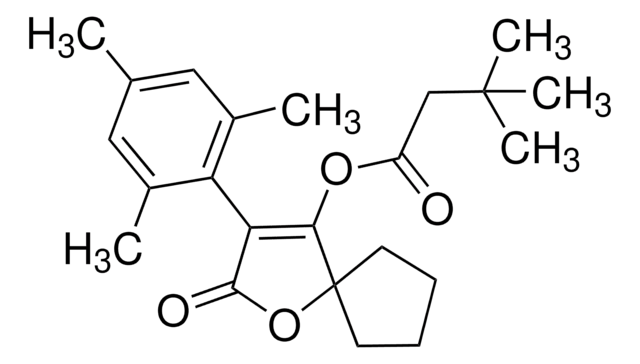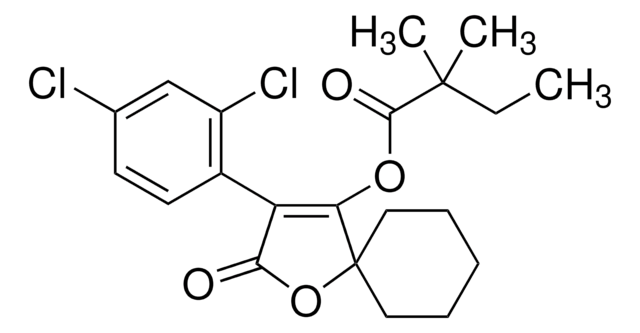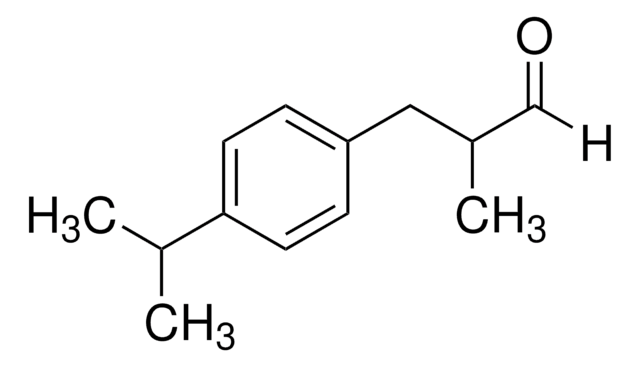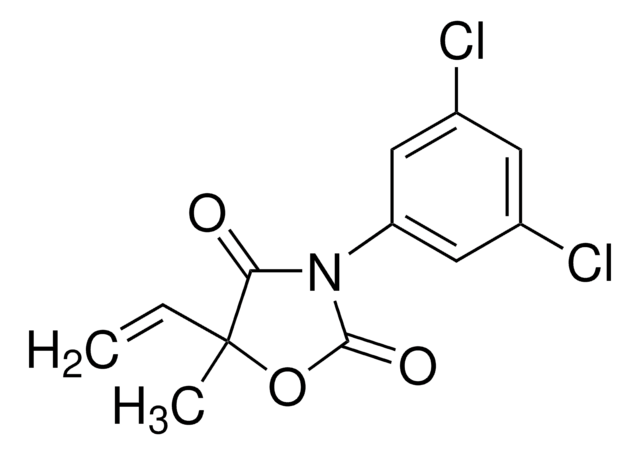CRM03908
Spirodiclofen
certified reference material, TraceCERT®, Manufactured by: Sigma-Aldrich Production GmbH, Switzerland
Sinonimo/i:
3-(2,4-Dichlorophenyl)-2-oxo-1-oxaspiro[4.5]dec-3-en-4-yl) 2,2-dimethylbutyrate
About This Item
Prodotti consigliati
Grado
certified reference material
TraceCERT®
Livello qualitativo
Nome Commerciale
TraceCERT®
Forma fisica
powder
Durata
limited shelf life, expiry date on the label
Produttore/marchio commerciale
Manufactured by: Sigma-Aldrich Production GmbH, Switzerland
Stringa SMILE
CCC(C)(C)C(=O)OC1=C(C(=O)OC12CCCCC2)c3ccc(Cl)cc3Cl
InChI
1S/C21H24Cl2O4/c1-4-20(2,3)19(25)26-17-16(14-9-8-13(22)12-15(14)23)18(24)27-21(17)10-6-5-7-11-21/h8-9,12H,4-7,10-11H2,1-3H3
DTDSAWVUFPGDMX-UHFFFAOYSA-N
Cerchi prodotti simili? Visita Guida al confronto tra prodotti
Descrizione generale
Spirodiclofen is a selective, non-systemic acaricide belonging to the new family of spirocyclic tetronic acids (keto-enols). It is highly active against spider mites, such as Panonychus, Tetranychus, Phyllocoptruta, Brevipalpus, and Aculus species in citrus, pome fruits, grapes, and nuts. Spirodiclofen targets lipid biosynthesis by inhibiting acetyl-coenzyme A carboxylase (ACCase) and it effectively controls the population of mites resistant to other acaricides.
Spirodiclofen has to be monitored in the Multiannual Control Programmes for Pesticides Residues (MACP), run within the EU and EFTA in/on products of plant origin. Maximum residue levels (MRLs) have been set according to Reg (EG) No 2016/1902 for spirodiclofen for various products of plant and animal origin from 0.004 to 2 mg/kg.
Spirodiclofen was initially included in Annex I to Directive 91/414/EEC on 1 August 2010 and is approved under Regulation (EC) No 1107/2009, following Commission Implementing Regulation (EU) No 540/2011. However, after its approval expired on 31 July 2020, Spirodiclofen is no longer approved in the European Union (EU) but is authorized in third countries for use on citrus fruits that might be fed to livestock.
Applicazioni
- Study the molecular mechanisms of spirodiclofen resistance using two highly resistant Tetranychus urticae strains with different genetic backgrounds
- To evaluate the sublethal effects of spirodiclofen, abamectin, and pyridaben on life-history traits and life-table parameters of two-spotted spider mites, Tetranychus urticae
- To evaluate the effect of a combination of spirodiclofen with other insecticides for the control of Brevipalpus yothersi in citrus
- Investigate the effects of salicylic acid treatment of tomato plants on the susceptibility of Tetranychus urticae to spirodiclofen, the activities of mite digestive enzymes, and its energy reserves
- Simultaneous determination of spirodiclofen, spiromesifen, and spirotetramat and their metabolites in edible fungi using a modified QuEChERS procedure and UHPLC-MS/MS
Prodotti consigliati
Note legali
Avvertenze
Danger
Indicazioni di pericolo
Consigli di prudenza
Classi di pericolo
Aquatic Chronic 1 - Carc. 1B - Repr. 2 - Skin Sens. 1B - STOT RE 2
Codice della classe di stoccaggio
6.1C - Combustible acute toxic Cat.3 / toxic compounds or compounds which causing chronic effects
Classe di pericolosità dell'acqua (WGK)
WGK 2
Punto d’infiammabilità (°F)
Not applicable
Punto d’infiammabilità (°C)
Not applicable
Scegli una delle versioni più recenti:
Certificati d'analisi (COA)
Non trovi la versione di tuo interesse?
Se hai bisogno di una versione specifica, puoi cercare il certificato tramite il numero di lotto.
Possiedi già questo prodotto?
I documenti relativi ai prodotti acquistati recentemente sono disponibili nell’Archivio dei documenti.
Il team dei nostri ricercatori vanta grande esperienza in tutte le aree della ricerca quali Life Science, scienza dei materiali, sintesi chimica, cromatografia, discipline analitiche, ecc..
Contatta l'Assistenza Tecnica.











